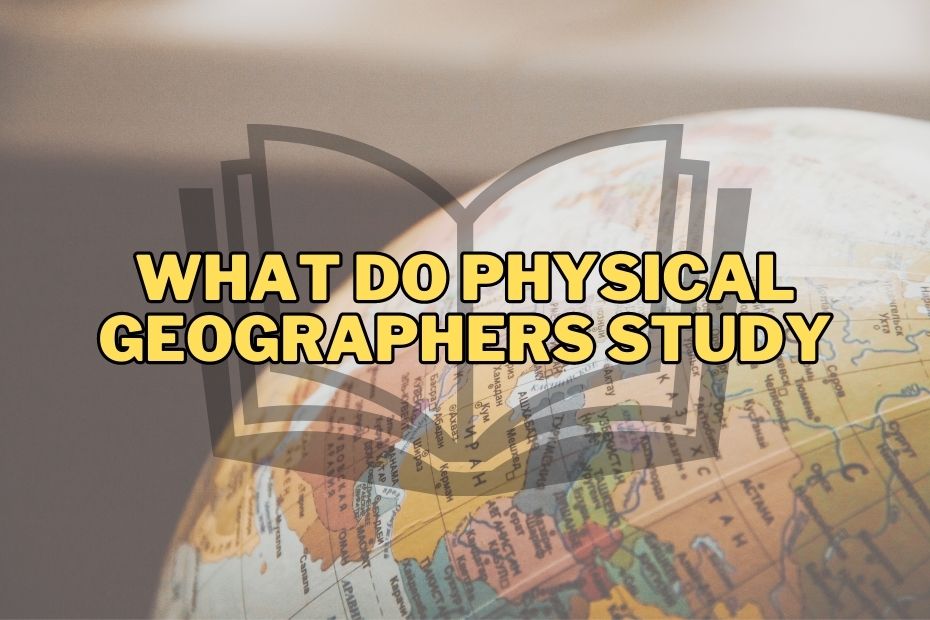Physical geography is a field of study that explores the natural processes and patterns of the Earth’s physical environment. It involves examining the interactions between the atmosphere, hydrosphere, lithosphere, and biosphere, and how they shape landscapes, climates, ecosystems, and human activities. In this article, we will delve into the fascinating world of physical geography and discuss What do physical geographers study?
Physical geographers study various aspects of the natural environment, including landforms, climate, soils, natural hazards, water, and plants.
Their research focuses on understanding and analyzing these features to gain insights into the Earth’s physical processes and the interactions between human activities and the environment.
What Do Physical Geographers Study?
Physical geography is concerned with understanding the natural environment and the processes that shape it. It examines the Earth’s physical features, such as mountains, rivers, deserts, and forests, and investigates the factors that contribute to their formation, evolution, and distribution. By studying physical geography, we can gain insights into the complex relationships between the Earth’s systems and how they impact our planet.
1. Geomorphology
Geomorphology is the study of landforms and the processes that create and modify them. Physical geographers analyze the forces of erosion, weathering, and tectonic activity that shape the Earth’s surface. They investigate the formation of mountains, valleys, canyons, and coastlines, as well as the impact of human activities on landforms.
2. Climatology
Climatology focuses on the study of climate and weather patterns. Physical geographers examine atmospheric conditions, such as temperature, precipitation, wind patterns, and atmospheric pressure, to understand how they vary across different regions and over time. They investigate climate change, extreme weather events, and the influence of climate on ecosystems and human societies.
3. Biogeography
Biogeography explores the distribution of plants, animals, and ecosystems across the Earth. Physical geographers study factors that affect the distribution of species, including climate, topography, soil composition, and human activities. They analyze biodiversity patterns, ecological relationships, and the impacts of habitat loss and fragmentation.
4. Hydrology
Hydrology is the study of water in all its forms, including rivers, lakes, glaciers, groundwater, and atmospheric moisture. Physical geographers investigate the movement, distribution, and quality of water resources. They analyze the hydrological cycle, water management strategies, and the impact of human activities on water availability and quality.
5. Pedology
Pedology focuses on the study of soils and their properties. Physical geographers examine soil formation, classification, and distribution. They analyze soil fertility, erosion processes, and the impact of land use practices on soil health. Understanding soil characteristics is crucial for agriculture, land management, and environmental conservation.
6. Glaciology
Glaciology is the study of ice and glaciers. Physical geographers investigate the formation, movement, and melting of glaciers, as well as their impact on landforms and ecosystems. They study past and present glacial activity, sea-level rise, and the contribution of glaciers to the global water cycle.
7. Environmental Management
Environmental management involves the application of geographical knowledge to address environmental challenges. Physical geographers contribute to the development of sustainable practices for land and resource use, conservation efforts, and the mitigation of natural hazards. They work closely with policymakers, scientists, and communities to promote environmental stewardship.
8. Spatial Analysis
Spatial analysis is a key tool used by physical geographers to examine geographic patterns and relationships. They employ various techniques, such as geographic information systems (GIS), to analyze and visualize data related to landforms, climate, ecosystems, and human activities. Spatial analysis helps in understanding the spatial distribution of phenomena and making informed decisions for resource management.
9. Remote Sensing
Remote sensing involves the collection and interpretation of data about the Earth’s surface using aerial and satellite imagery. Physical geographers use remote sensing techniques to monitor and analyze changes in land cover, vegetation, and environmental conditions. This technology aids in mapping, disaster assessment, and studying large-scale environmental processes.
What Do Physical Geographers Do?
Physical geographers are like detectives of our Earth’s landscapes! They study all the different parts of the Earth, including mountains, rivers, forests, deserts, and even the weather.
They try to understand why these parts look the way they do, how they change over time, and how they affect living things.
For example, they may study how a river changes its path over time, or why a desert is hot and dry. They also study the patterns of weather, like where it rains a lot or where it’s always sunny.
By studying these things, physical geographers help us learn more about our planet and how to take care of it.
Conclusion
Physical geography encompasses a wide range of topics and disciplines that contribute to our understanding of the Earth’s physical environment. From studying landforms and climate patterns to analyzing ecosystems and water resources, physical geographers play a crucial role in addressing environmental challenges and promoting sustainable practices.
By exploring the intricate relationships between natural systems and human activities, we can strive for a harmonious coexistence with our planet.
FAQs: What Do Physical Geographers Study?
What career opportunities are available for physical geographers?
Physical geographers can pursue careers in environmental consulting, urban planning, natural resource management, climate research, and academia, among others.
Is physical geography only focused on Earth?
While physical geography primarily focuses on Earth, its principles can be applied to the study of other planets and celestial bodies.
How does physical geography contribute to climate change research?
Physical geographers play a crucial role in studying climate change by examining historical climate records, analyzing climate models, and assessing the impact of human activities on the Earth’s climate system.
Are there any notable physical geographers in history?
Yes, several influential physical geographers have shaped the field, including Alexander von Humboldt, Carl Ritter, Ellen Churchill Semple, and Carl O. Sauer.
What tools do physical geographers use?
Physical geographers use various tools, including GIS (Geographic Information Systems), remote sensing technology, and field surveys.
